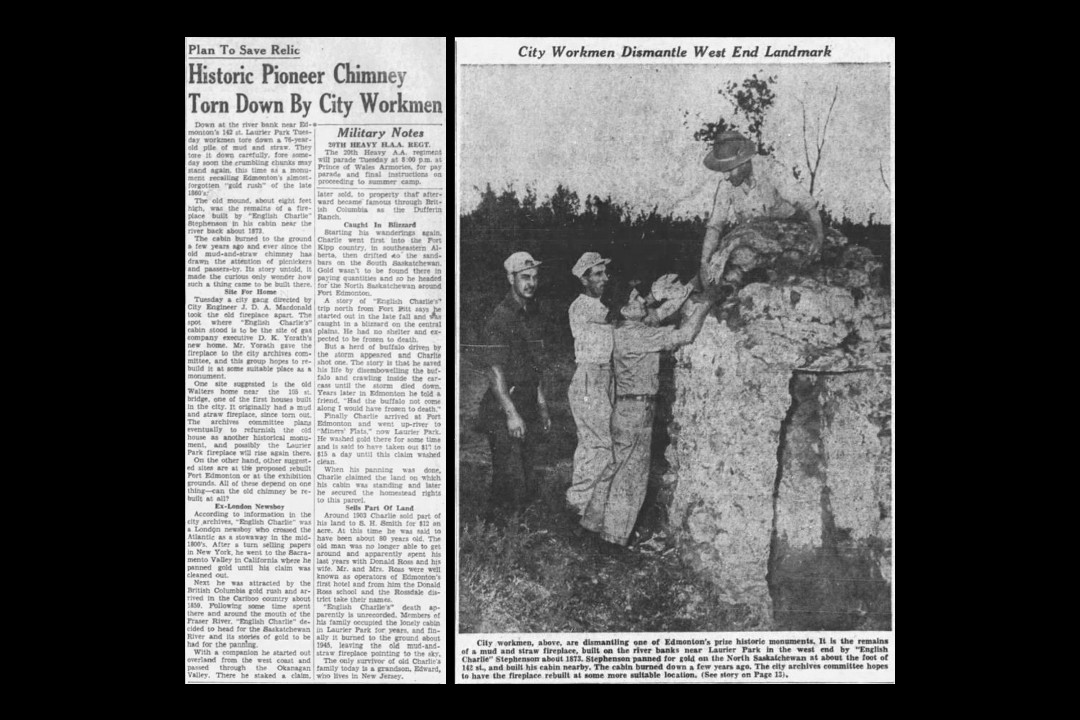On this day in 1949, city workers carefully dismantled an old relic left behind by English Charlie, one of the most colourful figures from Edmonton's short-lived gold rush.
It might look like just a stack of sticks and mud in a photo of the dismantling. But it was actually the remains of a fireplace that stood near the banks of the river for 75 years. As his nickname might suggest, English Charlie (aka Charlie Stevenson) was born in the United Kingdom. He worked as a newsboy in London until he stowed away on a ship bound for North America. He would stop in New York for a few years before hearing news of a gold rush in California. Eager to find fortune, he headed west. The long journey would take him to Sacramento, up the coast to British Columbia, and eventually through the Rocky Mountains into southern Alberta sometime around 1876.
Stevenson ended up in Fort Kipp (near current-day Lethbridge). There, he heard tantalizing rumours of large amounts of gold found along the banks of the North Saskatchewan River. Although it was late in the year, he began to trek north on foot. It would be a journey he would barely survive; former city alderman S.H. Smith wrote that Stevenson claimed to have shot a bison and climbed inside it to prevent freezing to death during a blizzard.
Stevenson eventually made it to Fort Edmonton, where he built a small cabin (and its long-lasting fireplace) near present-day Sir Wilfrid Laurier Park. He was one of the first residents of what would become known as "Miner's Flats." (Another early gold seeker to set up in the flats was Thomas Clover, who now lends his name to many parts of the city, including Clover Bar and Cloverdale.)
Edmonton is well-known for its role in several gold rushes. The fort was a vital stop for fortune-seekers looking to resupply on their way west, whether it be to the Fraser or Caribou goldfields in the 1850s or the Klondike decades later. But what is less known was the local rush, which saw people collecting gold and platinum from the North Saskatchewan.
This gold wasn't found in nuggets or lodes, however. The vast majority of it was in the form of "gold flour," tiny flakes that travel along the water and can collect in gravel or sand. While gold flour can be found sprinkled all along North Saskatchewan, Edmonton was particularly rich in it due to how bends in the river cause water to slow down and deposit its precious cargo. Platinum flakes can be found on the banks, too.
Early gold hunters would use gold pans or special sluicing boxes to separate the gold from the water and muck. It wasn't enough to make anyone fabulously wealthy, but enough for some to survive. Stevenson said he would find $12 to $15 daily while panning.
As technology improved, some would build skeletal dredging boats on the river, sifting through the river floor for gold flakes much more efficiently than an individual could do with a pan. The local gold industry peaked in the 1890s; by that time, there were a dozen dredging rigs on the river and some 300 miners working the banks of the river.
Edmonton's golden years ended quickly with the discovery of much larger gold yields in the Klondike. Many packed up to seek fortune in the Yukon, while others like English Charlie lived out their later years in Edmonton. Stevenson would retire from gold panning and sell off his land. Local gold would be later be given a chance to shine — when the Alberta legislature opened in 1912, the doors were ceremonially unlocked with a key made from Saskatchewan River gold. (The presumably valuable key almost immediately went missing and was never found.)
Once that old fireplace was cleared, the land was used for what would become another Edmonton historical site: Yorath House, which hosts artists-in-residence and is available for rent. And while Edmonton's small, local gold boom is now largely forgotten, the Klondike gave us the K in K-Days, which opens on July 21.
This is based on a clipping found on Vintage Edmonton, a daily look at Edmonton's history from armchair archivist @revRecluse — follow @VintageEdmonton for daily ephemera via Twitter.

